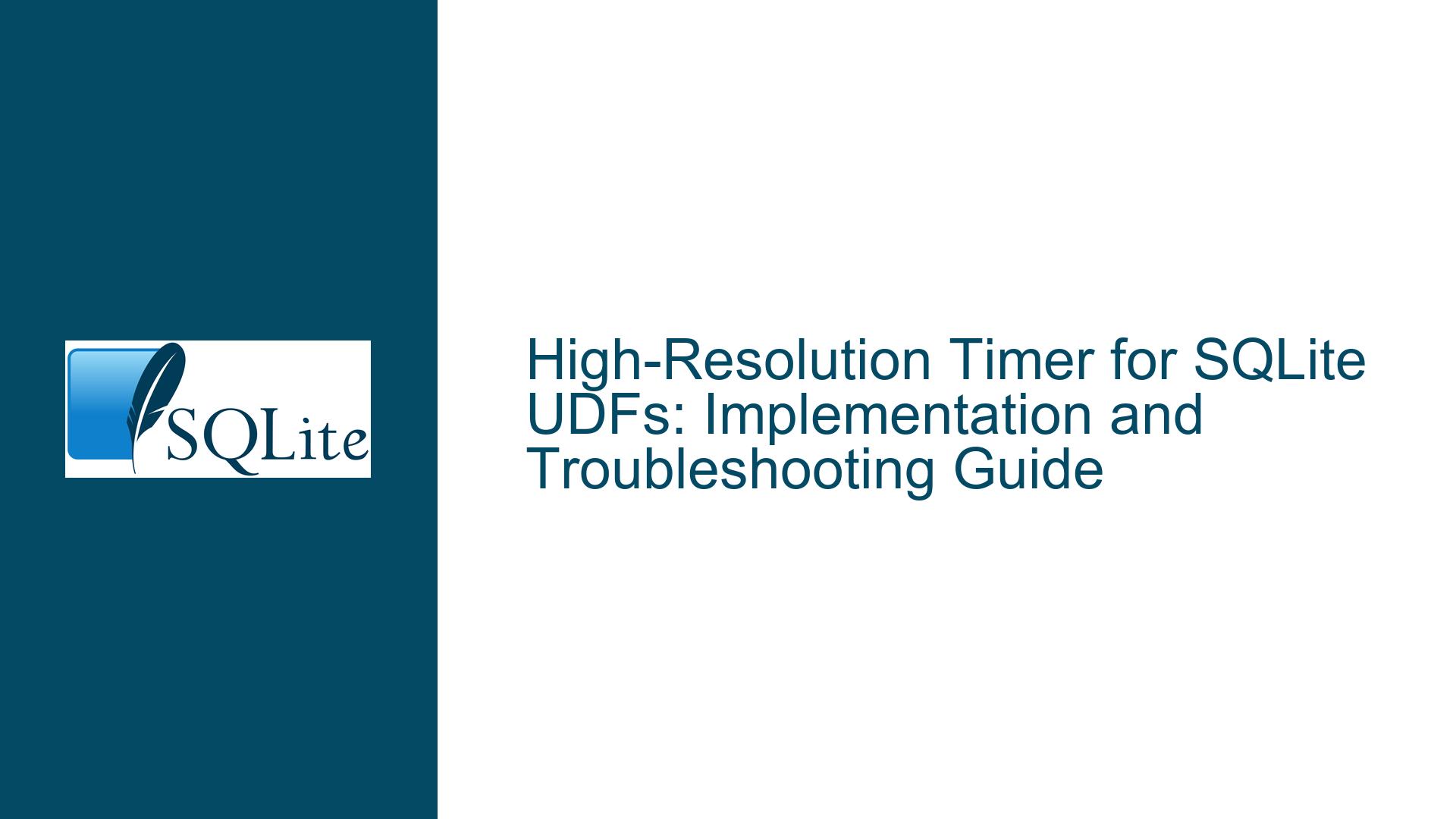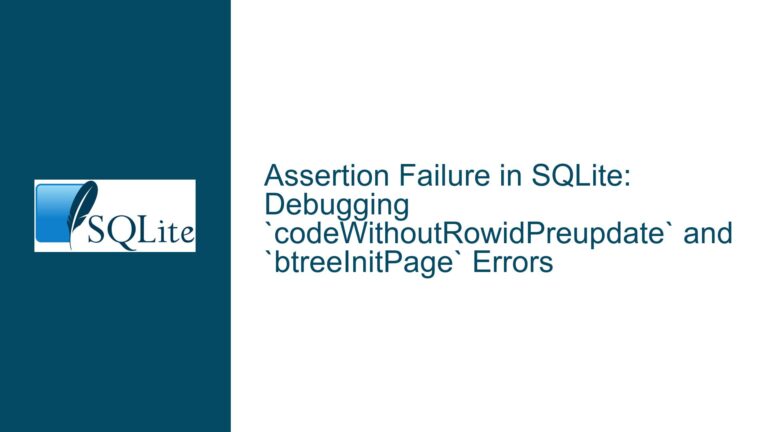High-Resolution Timer for SQLite UDFs: Implementation and Troubleshooting Guide
Understanding the High-Resolution Timer Extension for SQLite UDFs
The high-resolution timer extension for SQLite User-Defined Functions (UDFs) is designed to leverage modern CPU capabilities to measure time intervals with sub-microsecond precision. This functionality is particularly useful for developers who need to benchmark or optimize the execution speed of UDFs in SQLite. The extension provides a set of UDFs that allow users to mark timestamps and compute differences between them, offering a level of precision that is not achievable with standard SQLite datetime functions.
The extension is implemented in C and is available as pre-built binaries for Linux 64-bit and Windows 32-bit command-line interfaces (CLI). The source code is also provided, allowing developers to build the extension for other platforms or modify it to suit their specific needs. The head comment in the C source file documents the UDFs created by the extension and includes example usage, making it easier for developers to integrate the high-resolution timer into their SQLite projects.
The high-resolution timer extension works by accessing the CPU’s high-resolution performance counter, which is a hardware feature available on most modern processors. This counter increments at a very high frequency, often in the range of several gigahertz, allowing for extremely precise time measurements. By using this counter, the extension can measure time intervals with a resolution that is orders of magnitude finer than what is possible with standard system clocks.
One of the key advantages of this extension is its ability to provide accurate timing information even in environments where the system clock may be subject to significant jitter or drift. This is particularly important in performance-critical applications where even small variations in timing can have a significant impact on overall system performance. The extension also includes safeguards to ensure that the timing measurements are not affected by CPU frequency scaling or other system-level optimizations that could distort the results.
However, while the high-resolution timer extension offers significant benefits, it also introduces some complexities that developers need to be aware of. For example, the extension relies on platform-specific features, which means that it may not work correctly on all systems. Additionally, the use of high-resolution timers can introduce overhead, particularly in applications that make frequent calls to the timing functions. Developers need to carefully consider these factors when deciding whether to use the extension and how to integrate it into their projects.
Potential Challenges and Limitations of the High-Resolution Timer Extension
While the high-resolution timer extension for SQLite UDFs provides a powerful tool for measuring time intervals with sub-microsecond precision, there are several potential challenges and limitations that developers should be aware of. These issues can arise from a variety of factors, including platform-specific differences, hardware limitations, and the inherent complexities of working with high-resolution timers.
One of the primary challenges is the platform-specific nature of the high-resolution timer extension. The extension relies on the CPU’s high-resolution performance counter, which is a hardware feature that may not be available or accessible on all systems. For example, some older processors or embedded systems may not have a high-resolution counter, or the counter may not be exposed to user-space applications. In such cases, the extension may fail to initialize or may provide inaccurate timing measurements.
Another potential issue is the impact of CPU frequency scaling on the accuracy of the high-resolution timer. Many modern processors use dynamic frequency scaling to optimize power consumption and performance. This means that the CPU clock speed can vary depending on the workload, which can affect the frequency of the high-resolution counter. If the CPU frequency changes during the measurement interval, the timing results may be distorted. To mitigate this issue, the extension includes logic to detect and compensate for frequency scaling, but this adds complexity and may not be foolproof.
The overhead associated with using high-resolution timers is another consideration. While the extension is designed to minimize overhead, there is still a cost associated with accessing the high-resolution counter and performing the necessary calculations. In applications that make frequent calls to the timing functions, this overhead can accumulate and impact overall performance. Developers need to carefully balance the need for precise timing measurements with the potential performance impact of using the extension.
Additionally, the high-resolution timer extension may introduce subtle bugs or inconsistencies in certain scenarios. For example, if the extension is used in a multi-threaded application, there is a risk of race conditions or other synchronization issues. Similarly, if the extension is used in conjunction with other timing mechanisms, there may be conflicts or inconsistencies in the timing results. Developers need to thoroughly test the extension in their specific environment to ensure that it behaves as expected and does not introduce any unintended side effects.
Finally, the high-resolution timer extension may not be suitable for all use cases. While it provides extremely precise timing measurements, this level of precision may not be necessary or useful in all applications. In some cases, the additional complexity and overhead of using the extension may outweigh the benefits. Developers should carefully evaluate their specific requirements and consider whether the high-resolution timer extension is the right tool for their needs.
Best Practices for Implementing and Troubleshooting the High-Resolution Timer Extension
Implementing and troubleshooting the high-resolution timer extension for SQLite UDFs requires a thorough understanding of both the extension itself and the underlying hardware and software environment. By following best practices, developers can maximize the benefits of the extension while minimizing potential issues and challenges.
First and foremost, developers should ensure that their system supports the high-resolution timer extension. This includes verifying that the CPU has a high-resolution performance counter and that the counter is accessible to user-space applications. On some systems, it may be necessary to enable certain kernel features or configure system settings to allow access to the high-resolution counter. Developers should consult the documentation for their specific platform to determine the necessary steps.
Once the system is properly configured, developers should carefully review the documentation and example usage provided in the C source file for the extension. This documentation provides detailed information on the UDFs created by the extension, including their parameters, return values, and usage examples. By understanding how the UDFs work, developers can avoid common pitfalls and ensure that they are using the extension correctly.
When integrating the high-resolution timer extension into a SQLite project, developers should consider the potential impact of CPU frequency scaling on the accuracy of the timing measurements. To mitigate this issue, developers can use the extension’s built-in logic to detect and compensate for frequency scaling. However, it is also a good idea to monitor the CPU frequency during the measurement interval and adjust the timing results if necessary. This can be done using platform-specific tools or libraries that provide access to CPU frequency information.
To minimize the overhead associated with using high-resolution timers, developers should avoid making frequent calls to the timing functions unless absolutely necessary. Instead, they should aim to batch timing measurements or use the extension in a way that reduces the number of calls to the high-resolution counter. For example, developers can mark the start and end times of a larger block of code and compute the elapsed time once, rather than making multiple calls to the timing functions within the block.
When testing the high-resolution timer extension, developers should thoroughly evaluate its behavior in their specific environment. This includes testing the extension in different scenarios, such as single-threaded and multi-threaded applications, and under different workloads. Developers should also compare the timing results provided by the extension with those from other timing mechanisms to ensure consistency and accuracy. If any discrepancies or issues are found, developers should investigate the root cause and make any necessary adjustments to the extension or their application.
Finally, developers should be aware of the limitations of the high-resolution timer extension and consider whether it is the right tool for their specific use case. In some cases, alternative timing mechanisms, such as standard SQLite datetime functions or platform-specific timing libraries, may be more appropriate. By carefully evaluating their requirements and considering the trade-offs, developers can make an informed decision about whether to use the high-resolution timer extension and how to best integrate it into their projects.
In conclusion, the high-resolution timer extension for SQLite UDFs offers a powerful tool for measuring time intervals with sub-microsecond precision. However, it also introduces several challenges and complexities that developers need to be aware of. By following best practices and thoroughly testing the extension in their specific environment, developers can maximize the benefits of the extension while minimizing potential issues and ensuring accurate and reliable timing measurements.






